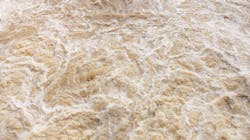What is onsite biological treatment?
Onsite biological treatment is a stage of onsite wastewater treatment that uses and promotes microorganisms’ biological processes to remove organic matter from wastewater.
Biological wastewater treatment processes organic matter, turning it into simpler substances. Thanks to the bacteria, the processed substances are either safer to include in effluent or can be more easily removed from the wastewater before discharge.
Biological treatment is part of secondary treatment. Before secondary treatment, primary treatment first removes substances that easily settle in wastewater, such as oils and suspended solids. In secondary treatment, naturally-occurring bacteria can break down any remaining biodegradable organic matter.
Editor's Note: This interview was sponsored by Veolia Water Technologies.
Types of biological treatment
Biological treatment can use either an anaerobic or aerobic environment. Aerobic treatment requires the use of oxygen in the microorganisms’ environment, while anerobic involves an environment deprived of oxygen.
These two types of environments will require different supporting systems, use different microbes, will result in different products and by-products.
Aerobic treatment produces less odor and is more efficient at removing nutrients. However, it requires more energy and maintenance, and produces biosolids that need proper disposal.
Anaerobic treatment produces much less sludge, and even produces biogas as a source of renewable energy and revenue.
The way that microorganisms are introduced into wastewater can also vary. This leads to two approaches in biological treatment: attached growth and suspended growth processes.
Suspended growth
Suspended growth processes comprise some of the most common forms of biological wastewater treatment. In this approach, the microorganisms are suspended in the wastewater that is being treated.
Some main types of aerobic suspended growth methods include: activated sludge, aerated lagoons, sequencing batch reactors (SBRs), and aerobic granulation.
The activated sludge process, for example, uses dissolved oxygen (i.e. aeration) to promote the growth of microorganisms. This approach can reduce solids like amino acids and ammonia into nitrites and nitrates through denitrification.
The treated wastewater then sits in a clarifier/settler, where the suspended microorganisms and other biological matter settle out as sludge. The settled sludge is then either reused in aeration or disposed.
Attached growth
In attached growth (also known as fixed film) systems, microorganisms are introduced as a thin layer of microbial mass that grows on an inert surface, like a rock. Wastewater passes over this microbial film, allowing for biological processes to begin purifying the wastewater.
Fixed-film systems can vary widely. These systems can have several types of different media types for their surfaces, can be either aerobic or anaerobic, can be static or mobile, and can be anywhere between fully submerged, partially submerged, or non-submerged.
Some types of attached growth systems include filter beds, rotating biological contactors, and constructed wetlands.
In rotating biological contactors, for example, the surface is a partially-submerged series of rotatable panels controlled by a motor. By rotating, these panels allow the microbial film to grow from both the nutrients in the wastewater and the oxygen from the air.
Eventually, the microbial film can grow so much that, from the forces of gravity and rotation, portions of it fall off the panel and into the wastewater. The effluent from this process then goes through a clarifier, where the organic matter can settle as sludge.
